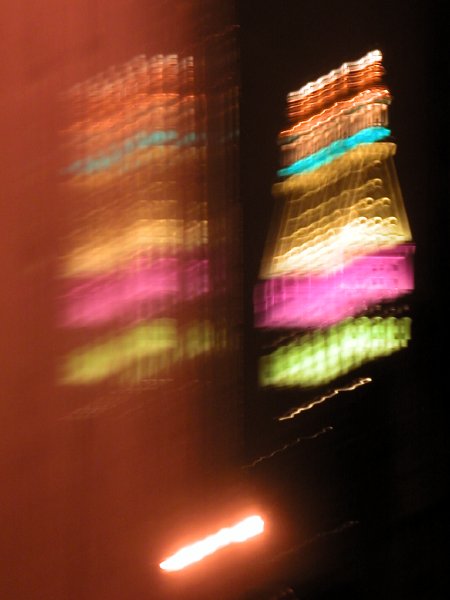
untitled (piebald Met Life Building and van doppel) 2005
There can only be one explanation for the exuberance of this neighborhood display tonight: The fecundity feast of Eostre [sic]. Excerpts from the Wikipedia entry for Easter:
The English and German names, "Easter" and "Ostern", seem clearly unrelated to Pesach [that is, Passover, to which the name for this Christian feast is related in all other European languages] etymologically and likely derive either from Eostremonat, an old Germanic month name, or Eostre, a Germanic goddess associated with the springtime, who as the 8th century English historian Bede records was honored with a festival during Eostremonat. It has been suggested that many of modern Easter's symbols, such as colored eggs and the Easter Bunny, are cultural remnants of Eostre's springtime festival and that Eostre merged with the Christian Pesach celebrations after the Germanic heathens were Christianized (see Easter as a Germanic Heathen festival below.), even though giving of eggs at spring festivals was not restricted to Germanic peoples and could be found among the Persians, the Romans, and the Jews.Anyway, in the spirit of this happy season, Barry and I have decided to share a great feast with friends tomorrow, built around an extremely pagan Agnello al forno.. . . .
According to the Bede, the word "Easter" is derived from the Old Norse Ostara or Eostre, a festival of spring at the vernal equinox, March 21, when nature is in resurrection after winter, hence, the symbolism of rabbits, notable for their fecundity, and the eggs, colored like rays of the returning sun and the aurora borealis. The Easter Bunny is a Western European tradition and has never been adopted by Orthodox Christians, showing as false the claim that the entire holiday is some sort of "Germanic Heathen" festival. Some historians assert that Bede falsely concluded the existence of goddess Eostre from the unquestionably real month name Eostremonat, as any references to such a goddess from other Germanic sources are missing. Children roll easter eggs in England and America but not in all traditionally Christian countries. They hunt the many-colored Easter eggs, brought by the Easter Bunny. Hidden in the play area, it has been argued, the vestiges of a fertility rite, the eggs and the rabbit both symbolizing fertility. (A rabbit, furthermore, was sometimes said to be the escort of the goddess, but there are no pre-19th century sources for this.) However, such claims ignore at least as ancient use of eggs as symbolic gifts among the Persians and Jews.